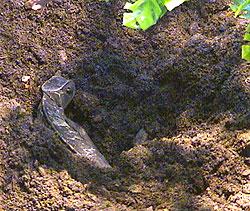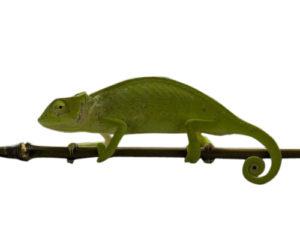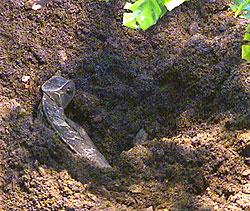Welcome to the Senegal Chameleon Care Sheet section, this area is divided in to several separate sub sections - the introduction (this page), the housing Senegal Chameleons page, temperature and humidity, feeding Senegal Chameleons and breeding Senegal Chameleons sections.
Senegal Chameleon Care Sheet
The Senegal Chameleon (Chamaeleo senegalensis) is native to strangeley enough, Senegal in Western Africa, hence its common name. Generally speaking it is a small to medium size as far as chameleons go getting to around 12 inches in length half being the tail.
The picture opposite shows a female digging a hole in ready to depesit her eggs.
There are thousands of these chaneleons imported in to the pet trade each year and a great many of them don't live past a few months.
This is because they can get stressed and as they are wild collected they usually have internal parasites (worms) which in the wild would not be too much of a problem.
As soon as the animal becomes stressed the parasites can start to become a problem and can drain the strength away from an already stressed lizard.
A trip to the vets for a dose of worming treatment will quickly resolve this problem pretty inexpensively.


This is a day old Senegal Chameleon and the total length of the babies is around 2 inches.
These chameleons are generally green although they have the ability do turn almost black as well as a yellow colour.
The males are smaller than the females and have a small 'bulge' at the base of their tail (either side of the vent)
Senegal Chameleons are not a good starter chameleon (if there is such a thing) unless they are captive bred specimens.
READ MORE: Yemen Chameleon Care SheetWild collected ones will not drink from waterbowls so the leaves and walls of the enclosure have to be sprayed or a waterfall installed, captive bred ones have been trained to drink from a water bowl.
Once settled though whether wild collected or captive bred they make excellent medium sized pet chameleons.
Chameleons are very shy creatures normally and want to hide away in a branch.
In captivity they will become quite tame and can be readily handled, many will often feed from your hand with their long sticky tipped tongue.
Housing Senegal Chameleons
Chameleons should not be kept in sealed glass tanks that were designed for fish or other animals. There are a few reasons for not keeping chameleons in a glass tank but the main two are:
A. Chameleons can suffer from respiratory (breathing) infections if kept in stale air, a constant flow of fresh air is essential in keeping chameleons.
B. They can see their reflection in the glass and assume it's another chameleon in their territory. This will cause them to become aggressive to it and this will escalate as the reflection does the same - the result is a very stressed chameleon
BUY ONEThe best enclosure I have seen for chameleons is the Reptarium from Apogee.
These consist of a strong plastic frame with a strong and machine washable mesh cover which has zip off ends.
The size of the enclosure should be large enough to allow the chameleon to move freely around to thermo-regulate itself (keep the right temperature). A size of 30 x 16 x 16 is a minimum (38G version) but a 30 x 16 x 28 inch one is better (65G version).
The Cage should have no substrate in the bottom as this can be accidentally eaten by the chameleon as it tries to catch food.
Instead plain paper should be used or better still, buy Reptarium Softray which slips over the base of the frame prior to putting on the outer mesh.
This is also waterproof.
In the UK you can safely put the entire cage outdoors in a sunny position. As the cage is mesh it will not overheat and the chameleons will benefit from the summer sun.
Make sure to spray at least twice a day if keeping outdoors during the summer and make sure that there is some shady places within the cage or put part of it in the shade and part in the sun, this will allow the lizard to bask safely.
Whatever kind of tank you choose you will need at least one other piece of equipment, a large tree branch, this should have at least 6 side shoots.
The branch should start at the bottom left corner and rise to the top right corner with the side branches going right up to the mesh sides.
This will allow the reptile to move in to either warm areas or cooler ones (thermo regulation).
A generous amount of artificial plant vine should be wrapped around the branch to act as cover for the chameleon, it will sleep in the 'leafy' area at night.
They are best kept singly as males will fight other males and keeping a male and female together will result in an unwanted pregnancy!.
You can keep two females together so long as the cage is large enough.
Temperature for Senegal Chameleons
Senegal Chameleons like to bask under a spot light during the day and need some form of 'background' heat 24 hours a day.
The easiest way to accomplish this it to use a 100w Ceramic heal element and a reflector above the enclosure more or less centred up.
BUY ONEIn addition use a 100w spot light aimed at a particular fork in the tree branch.
The chameleon will position its body at a right angle to the light and warm up its body, it will then take a walk around its tree or branch in search of food and water.
The temperature inside the cage where the chameleon is going to be basking should be no more than 35C to prevent it from burning itself.
You will need to test the temperature at the fork in the branch and then again just inside the top of the cage, this is because when the chameleon is sunning itself the casque on its head may get too hot.
Adjust the height of the light to get them temperature right.
One other important element for keeping chameleons is a source of UV light, chameleons need the UV light from the sun in order to metabolise the calcium in their diet.
READ MORE: Keeping ChameleonsIf they can not take advantage of the calcium they will not be able to grow bones properly and will eventually die. A 24″ Reptisun 5 lamp and fitting will do the trick just nicely.
The strip tube should be replaced every 6 months as the UV element gradually stops providing the required levels of UVB light.
The lighting system should be set to come on for 12 hours a day, this can be done using a simple timer switch.
Feeding Senegal Chameleons
Senegal Chameleons in common with other chameleons love yellow coloured food insects, particularly locusts!.
You can give an adult chameleon large or extra large locust and they would normally eat 2 or 4 per sitting.
Don't feed adult locust as they are bit too large.
BUY LIVEFOODOther foods which can be given include crickets, pinkie mice and occasionally soft fruit like peach.
The food being fed should be lightly dusted with a food supplement powder on every occasion until they are 9 - 12 months old, you need then only do it once a week.
This will give the growing chameleon all the minerals needed for speedy growth. Females will require more calcium in their diet to help with egg production so if the female is gravid (pregnant) give her food which is dusted at every feeding.
The size of the food given should be decided by the size of the lizard. Adult chameleons can manage large live foods used like crickets and locust plus the occasional pinkie mouse.
Juveniles up to 2 - 3 months can take curly wing flies, small to medium sizes crickets and small to medium sized locust, anything larger may pose a threat to the chameleon.
The only food given to small hatchlings should be pinhead crickets or preferably fat flightless fruit flies. Whichever you choose they should be lightly dusted with food supplement to boost their nutritive value.
Feed youngsters several times a day but DO NOT leave uneaten food in with them overnight as the food can atack the lizards.
If feeding crickets to your Yemen make sure that there are none left in the cage overnight as they can attack the chameleon as it sleeps.
ALWAYS remove uneaten food items at night.
If your animal is wild collected then you should include a water bowl in addition to spraying the plants and walls daily.
If your animal is captive bred then it should be drinking from the bowl and the plants wont need wetting. The water should be changed daily.
Breeding Senegal Chameleon

A large container filled with at least 6 inches of damp compost or sand should be introduced in to the tank approximately 4 weeks after mating.
The female will dig burrows in the egg laying box when she is ready to lay her eggs. This is usually around 10 weeks but it can be more or less.
During the day the female will make test holes in the compost so it must be damp enough to dig in but not collapse.
Senegal chameleons start life with a batch of eggs ready for their life of egg laying. The female becomes sexually mature at around 4 months.
This is a critical time for the female chameleon as she has to be mated when she first becomes available.
It is thought that if a female misses getting pregnant (gravid) at the first available date then it is likely to die later due to being egg bound and unable to lay the eggs.
Wild collected females are usually gravid if they are of suitable age.
The male becomes sexually active at around the same period and will begin to show off to the females. He will advertise himself by walking parallel with the female in his finest colours and neck puffed out.
His tail may be held in a stiff strait line behind rather than being curled.
Mating can be a dangerous time for females as the courtship can be pretty rough. The male will often bite the female quite hard before mating.
If she is not ready for mating or if already gravid she will turn a dark colour and perhaps try to imitate another male.
If she is ready then mating is commenced several times in a 24 hour period. Keep a close watch at this time to make sure the female isn't being hurt in the process.
Once you're sure she has mated it is time to separate them.
The early spring is a good time to mate Senegals in the UK. This allows the eggs to develop naturally during the summer when temperatures rarely drop to below around 14C at night.
If you want to use mechanical means they you can breed them all year round. A thermostatically controlled incubation unit can either be bought or made and allows temprature to be maintained accurately.
As the female is now going in to egg production mode so she will need a good quality vitamin & mineral supplement dusted on to the crickets etc prior to feeding.
Make sure there's plenty of calcium available for egg shell production.
This is also the an ideal opportunity to change the UV light source. The strip tube will need changing every 6 months as they slowly stop producing UV (ultra violet) in sufficient quantities.
Whilst the light in general may not seem to change over the six months, the invisible spectrum (what you can't see) such as the UV wavelength begins to degenerate making it useless.
This Chameleon has a ZooMed™ ReptiSun 5 strip tube.
The new light fitting will produce UV in the right proportions and strength for the lizard.
At night she will make the real tunnel and lay between 30 - 70 eggs. The eggs themselves have soft skins rather than hard ones like a chicken and they are oval shaped.
They may have a yellow/cream colour when first exposed but will dry to a pure white.
The eggs should be cleaned of any compost sticking to them, do this VERY carefully with a soft artists brush.
DO NOT wash the eggs under a tap, this will wash away a protective film on the eggs they will probably die and rot during incubation.
The dry eggs should now be placed in an incubation chamber of some kind. A simply solution is to use VENTILATED cricket tubs.
A substrate or damp vermiculite should be put in to 2/3's the depth of the tub.
The vermiculite should be measured by WEIGHT and not volume.
Each 1 ounce of vermiculite should have 1 ounce of water added. To create a damp crumbly texture.
The eggs should be laid out at 1 inch intervals, in a cricket tub you can get 8 eggs. The eggs should be 1/2 to 3/4 buried in the damp vermiculite making sure the vermiculite is in contact with the egg.
Replace the lid on the container.
The incubation time will be determined by the temperature at which they are kept.
For the first 4 months the temperature should be 75F during the day and dropping to a minimum 60F at night.
The eggs hatch better if kept in complete darkness so make sure to put the eggs somewhere dark and safe.
The eggs will need checking regularly to remove any that have gone off or are mouldy. A top up with water may be required to keep the vermiculite moist.
If it's dry then add 20ml of water to the vermiculite in one corner.
If all goes well your eggs should begin hatching after around 6 - 7 months. The first signs will be the egg changing colour as the embryo shows through.
The egg may form beads of moisture on the surface (sweating) and the egg may collapse as shown here.
This young chameleon has slit the end of the egg to allow it to breath. The hatchling may stay like this for a full day or more. DO NOT remove the lizard from the egg.
During this period the chameleon is absorbing the last of the yolk in to its body.
After all the wait and effort you will be thrilled to see the first little Yemen Chameleons as they emerge over the following few weeks.
This batch hatched over a 3 week period but there are still 3 seemingly viable eggs left.
To start them off well you need to keep them in a well ventilated container like an Aquazoo 5.
The tank should have at least one plastic vine plant in there of some kind to act as a shelter for the hatchlings.
Place no more then 5 in each Aquazo to prevent overcrowding.
Provide heat with a ceramic lamp (60w) placed 7 inches above the tank. The temperature should be 20C with no spot lights on, this remains on 24 hours a day.
To supplement the heat during the day a spot light is provided for basking purposes.
This light is again placed 7 inches above the enclosure and the temperature under the spot light should be no more than 30C.
There should always be cool retreat so the lizards can thermoregulate (keeping at the right temperature).
A new UV strip tube should be purchased to make sure the lizards receive the full benefits of the light, ZooMed™ ReptiSun 5 lamps work well.
Spray the walls and plants with water every morning and every late afternoon. Make sure that you don't spray the babies directly, just the plants and walls of the tank.
The idea is to get the plants to have droplets of water on them but no water is allowed to collect in the bottom of the tank, small chameleons can drown in a tiny pool of water!
Feeding should commence the day after hatching and should be fat flightless fruit flies dusted with supplement powder, do this after the plants have dried (2 hours) so that the flies don't drown in water.
The chameleons instinctively know how to use their long sticky tipped tongue and it is a joy to watch the hatchlings taking aim and catching their first flies!
